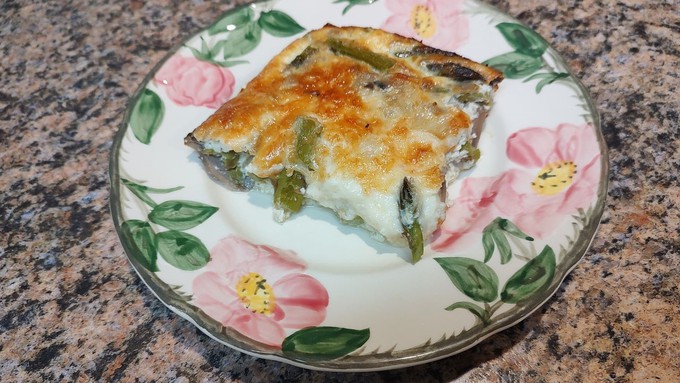
Recipe: Easy asparagus-mushroom bake with eggs and cheese

Light and creamy, asparagus-mushroom bake can be a meatless main course or side dish. Debbie Arrington
This easy, eggy casserole showcases one of my favorite vegetables of early spring – asparagus.
With a light and creamy egg base, this dish is perfect for brunch or as the main course in a meatless meal. It also works as a side dish for upcoming family celebrations such as Easter or Mother’s Day.
Precooking the asparagus with the mushrooms and onion eliminates most of the vegetable’s excess moisture. Otherwise, the casserole can come out soggy.
Asparagus-mushroom bake
Makes 4 to 6 servings
2 tablespoons olive oil
½ cup onion, chopped
2 cups white or cremini mushrooms, sliced
1 pound asparagus, cut into 1-inch pieces
¼ cup water
4 eggs
1 cup milk
¼ teaspoon hot sauce
1-1/2 cups jack cheese, grated
Preheat oven to 350 degrees F.
In a large skillet, heat oil. Saute onion over medium heat until translucent. Add mushrooms and continue sauteing until limp. Add asparagus and stir fry until pieces start to change color to bright green. Add water and cover pan. Turn heat down and let asparagus-mushroom mixture simmer until asparagus is tender, about 7 to 10 minutes depending on the thickness of the asparagus.
In a medium bowl, beat eggs until light. Add milk and mix to combine. Stir in hot sauce, then add the cheese.
Prepare an 8- by 8-inch baking dish; grease or spray with non-stick cooking spray.
Drain asparagus-mushroom mixture well, squeezing out as much moisture as possible. Transfer asparagus-mushroom mixture to prepared pan. Pour egg mixture over asparagus-mushroom mixture. Using a wooden spoon, gently swirl combined mixtures so asparagus is well distributed and all pieces are submerged in the egg mixture.
Place casserole on center rack in preheated oven. Bake casserole in 350-degree oven until top is golden and puffy, about 45 minutes.
Let cool slightly and serve.
Comments
0 comments have been posted.Sacramento Digs Gardening to your inbox.
Sites We Like
Garden Checklist for week of May 12
Get your gardening chores and irrigation done early in the day before temperatures rise.
* Plant, plant, plant! It’s prime planting season in the Sacramento area. Time to set out those tomato transplants along with peppers and eggplants. Pinch off any flowers on new transplants to make them concentrate on establishing roots instead of setting premature fruit.
* Direct-seed melons, cucumbers, summer squash, corn, radishes, pumpkins and annual herbs such as basil.
* Harvest cabbage, lettuce, peas and green onions. This heat will cause leafy greens and onions to flower; pick them before they bolt.
* In the flower garden, direct-seed sunflowers, cosmos, salvia, zinnias, marigolds, celosia and asters.
* Plant dahlia tubers. Other perennials to set out include verbena, coreopsis, coneflower and astilbe.
* Transplant petunias, marigolds and perennial flowers such as astilbe, columbine, coneflowers, coreopsis, dahlias, rudbeckia and verbena.
* Keep an eye out for slugs, snails, earwigs and aphids that want to dine on tender new growth.
* Feed summer bloomers with a balanced fertilizer.
* For continued bloom, cut off spent flowers on roses as well as other flowering plants.
* Got fruit trees? If you haven't already done so, thin orchard fruit such as apples, peaches, pears, pluots and plums before they grow too heavy, breaking branches or even splitting the tree. Leave the largest fruit on the branch, culling the smaller ones, and allow for 5 to 6 inches (or a hand's worth) between each fruit.
* Thin grape bunches, again leaving about 6 inches between them. For the remaining bunches, prune off the "tail" end, about the bottom third of the bunch, so that the plant's energy is concentrated in the fruit closest to the branch.
* As spring-flowering shrubs finish blooming, give them a little pruning to shape them, removing old and dead wood. Lightly trim azaleas, fuchsias and marguerites for bushier plants.
* Add mulch to the garden to help keep that precious water from evaporating. Mulch also cuts down on weeds. But don’t let it mound around the stems or trunks of trees or shrubs. Leave about a 6-inch to 1-foot circle to avoid crown rot or other problems.